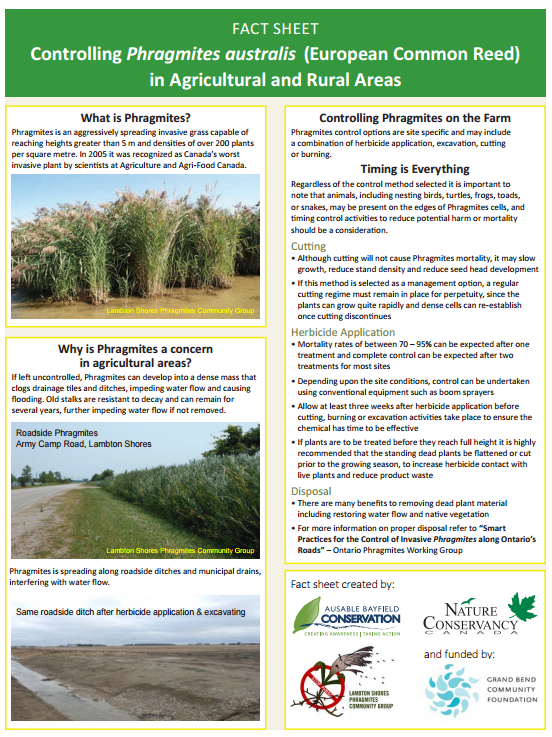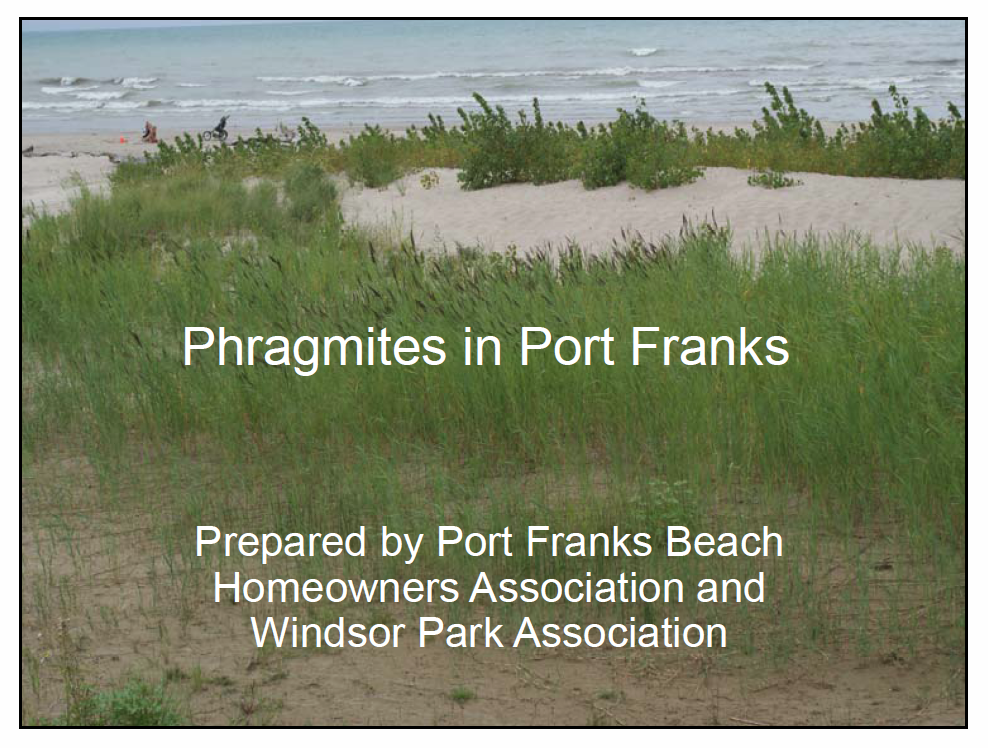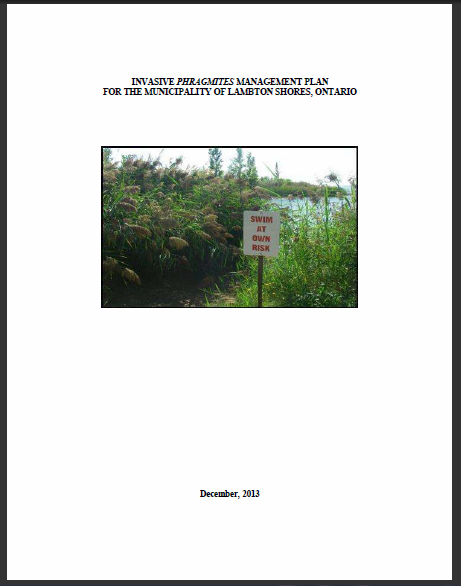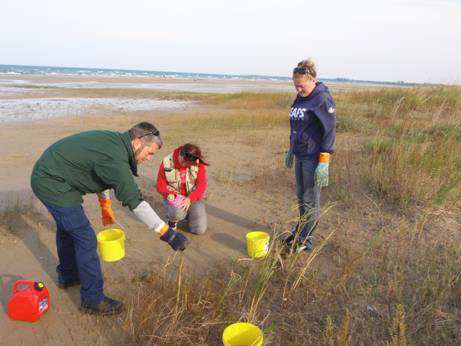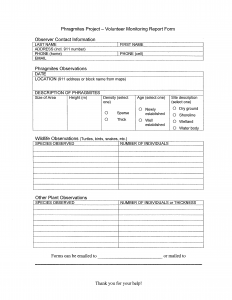
Lambton Shores, Ontario
Background
Providing regional coordination for local management
GLPC Editor’s Note: This case study showcases locally-focused management that is supported by a volunteer-led regional coordinating body. This model is most applicable for groups that are able to spend time communicating and building relationships among local government officials and community members.
Authors: Nancy Vidler and Bill MacDonald
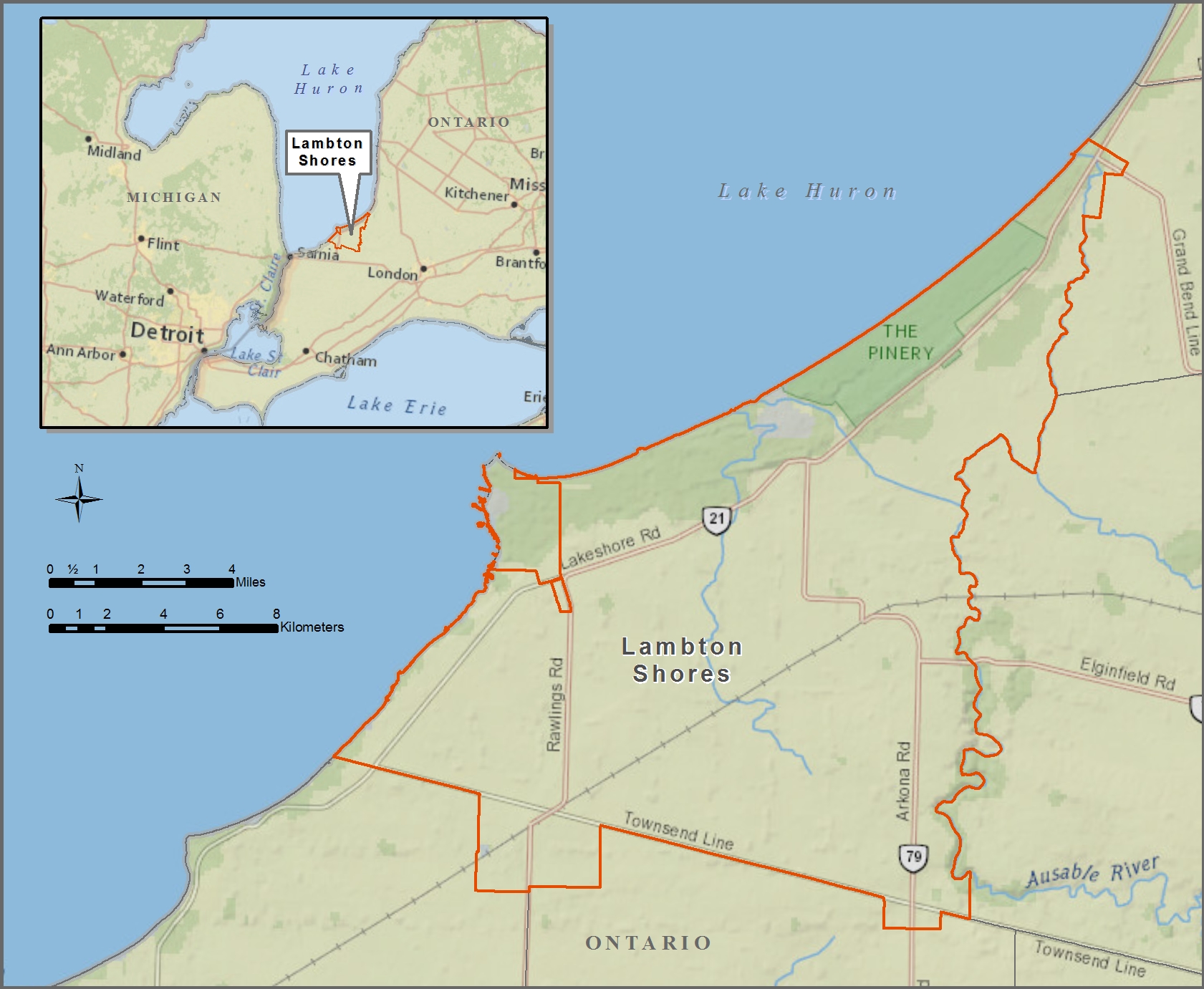
Lambton Shores is located along the south-eastern coastline of Like Huron
In 2009, when non-native Phragmites appeared on the Port Franks beach in southwest Ontario, two beach associations got together to form the Lambton Shores Phragmites Community Group (LSPCG). The LSPCG initiated a regional strategy to manage non-native Phragmites throughout the Municipality of Lambton Shores (MLS), a 331 square kilometer area located in the southeast basin of Lake Huron. This area contains many provincially significant and globally rare natural habitats including coastal dunes and wetlands, Carolinian core forest, and oak savannah that the LSPCG wants to protect from invasion by non-native Phragmites.
Large monoculture stands of non-native Phragmites are present along the Lake Huron shoreline, interior wetlands, roadsides, agricultural ditches and drains, lagoons, golf courses and parks. As of 2015, over 323 acres of coastal shorelines and 167 km (105 miles) of roadsides were infested. Due to the extensive area, diverse land ownership, multiple jurisdictions, and differing stages of non-native Phragmites management, the MLS was divided into seven Phragmites Management Areas (PMAs). For some PMAs, restoration programs are already well underway while other have only just initiated management. Overall, the LSPCG initiated remediation work on over 300 acres by the end of 2014.
The LSPCG was recognized by the Province of Ontario’s Ministry of the Environment and Climate Change with an Honourable Mention for Environmental Achievement in 2013, and by Lambton Wildlife Inc., and the Lambton County Museum for its achievements. The group also received Ausable Bayfield Conservation Authority’s 2016 Conservationist of the Year award.
Eleven components for successful projects within the MLS:
- understand the scope of the problem,
- establish of a Program Coordinator position,
- acquire sufficient funds,
- implement of an education program,
- engage the local community,
- use appropriate initial control techniques and follow up as necessary,
- establish a long term control program,
- track activities, efficacy, success, and challenges,
- list non-native Phragmites as a noxious weed
- expand the control program outside of the Municipal jurisdiction, and
- obtain herbicides appropriate and legal for overwater use.
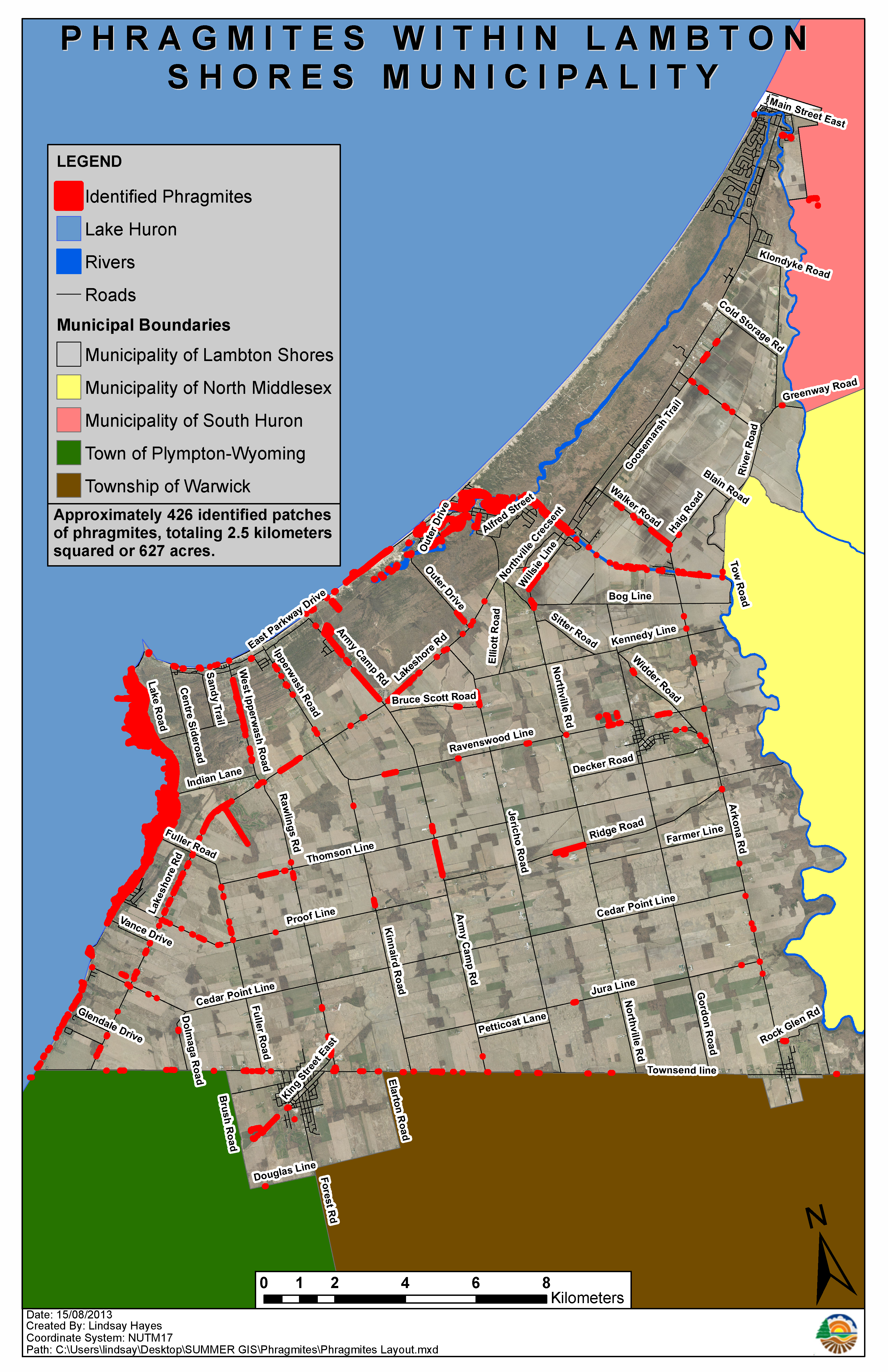
Partnerships and Administration
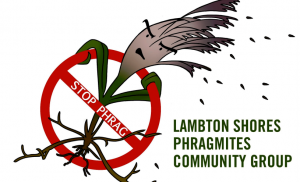 The LSPCG is a grass-roots organization led by eight volunteer board members, formalized under a Terms of Reference, and supported by a resource team that includes a wetland ecologist, a contractor well known in the area for specializing in sensitive habitats, and the Lake Huron Centre for Coastal Conservation. Initiative partners include landowners, homeowners associations, non-profit organizations, local and provincial agencies, First Nations, and private corporations. Local communities impacted by non-native Phragmites are engaged through LSPCG subcommittees that include local volunteers that help form neighbourhood connections, monitor treatment areas, and organize other volunteers.
The LSPCG is a grass-roots organization led by eight volunteer board members, formalized under a Terms of Reference, and supported by a resource team that includes a wetland ecologist, a contractor well known in the area for specializing in sensitive habitats, and the Lake Huron Centre for Coastal Conservation. Initiative partners include landowners, homeowners associations, non-profit organizations, local and provincial agencies, First Nations, and private corporations. Local communities impacted by non-native Phragmites are engaged through LSPCG subcommittees that include local volunteers that help form neighbourhood connections, monitor treatment areas, and organize other volunteers.
The volunteer LSPCG board members currently coordinate the program for the MLS. To reduce volunteer burn-out and ensure the long-term performance of the program, LSPCG recommended that this position should be taken up by an employee of the MLS. Eventually, the goal is for the subcommittees to be able to function with more self-sufficiency, with background support, materials, and coordination maintained centrally.
Though landowners that are uninterested in participating in the program remain a challenge, this broad partner base facilitates cost-sharing for community events, resource and skill sharing through in-kind services, and assistance with broader outreach to the community. It also gives credibility to the larger organization, improves trust among members, and reduces red-tape when applying for permits.
Partnership Example: Community Information Sessions
LSPCG identified the need for community information sessions and developed a grant application to the Grand Bend Community Foundation. The Ausable Bayfield Conservation Authority (ABCA) prepared the application with LSPCG’s assistance and signed as the applicant. The ABCA’s Communication Specialist developed media releases and flyers. LSPCG arranged the speakers, including the President of the Ontario Federation of Agriculture, a Nature Conservancy Canada representative, the Mayor of Lambton Shores, a Drainage Superintendent from a neighbouring community, and a local area farmer. The MLS and the Grand Bend Community Health Centre donated their facilities, and local farmers and businesses donated door prizes for the events. Local newspapers gave news coverage.
In 2014, MLS adopted the Invasive Phragmites Management Plan, a formal, long-term plan to guide management in the region. The LSPCG has helped improve the coordination of management across boundaries despite jurisdictional issues and low provincial engagement. A meeting between county and municipal managers and roadside superintendents in 2012, led to significant improvements in coordination; the MLS and county began hiring the same contractor and committed money ($30,000 and $150,000 respectively between 2013 and 2015) to manage roadside populations.
Because the LSPCG is not a registered organization, partner organizations must serve as the applicants when applying for grant funding. Grants are typically sought individually for each project site, and applying for grants is an ongoing task. While grants provide significant resources, they come with several challenges. Some grants have inflexible dates and do not allow funds to be carried over into the next fiscal year, despite variable weather and site conditions that may not be conducive for the required activities in the given time period. Many of the grants LSPCG partners have received have been limited to one year, and some did not fund herbicide application. Additional funding provided by donations from partners has been critical for the maintenance work needed in subsequent years.
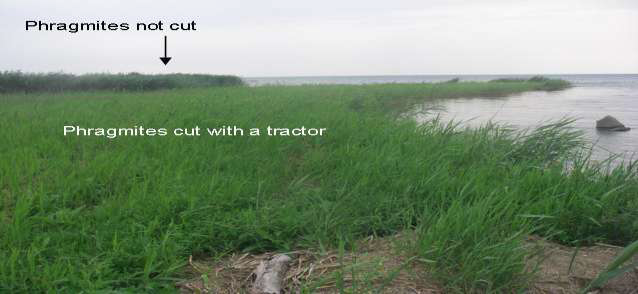
Section of dense Phragmites that had been cut along the Lake Huron shoreline at Kettle Point. Photo courtesy of Janice Gilbert
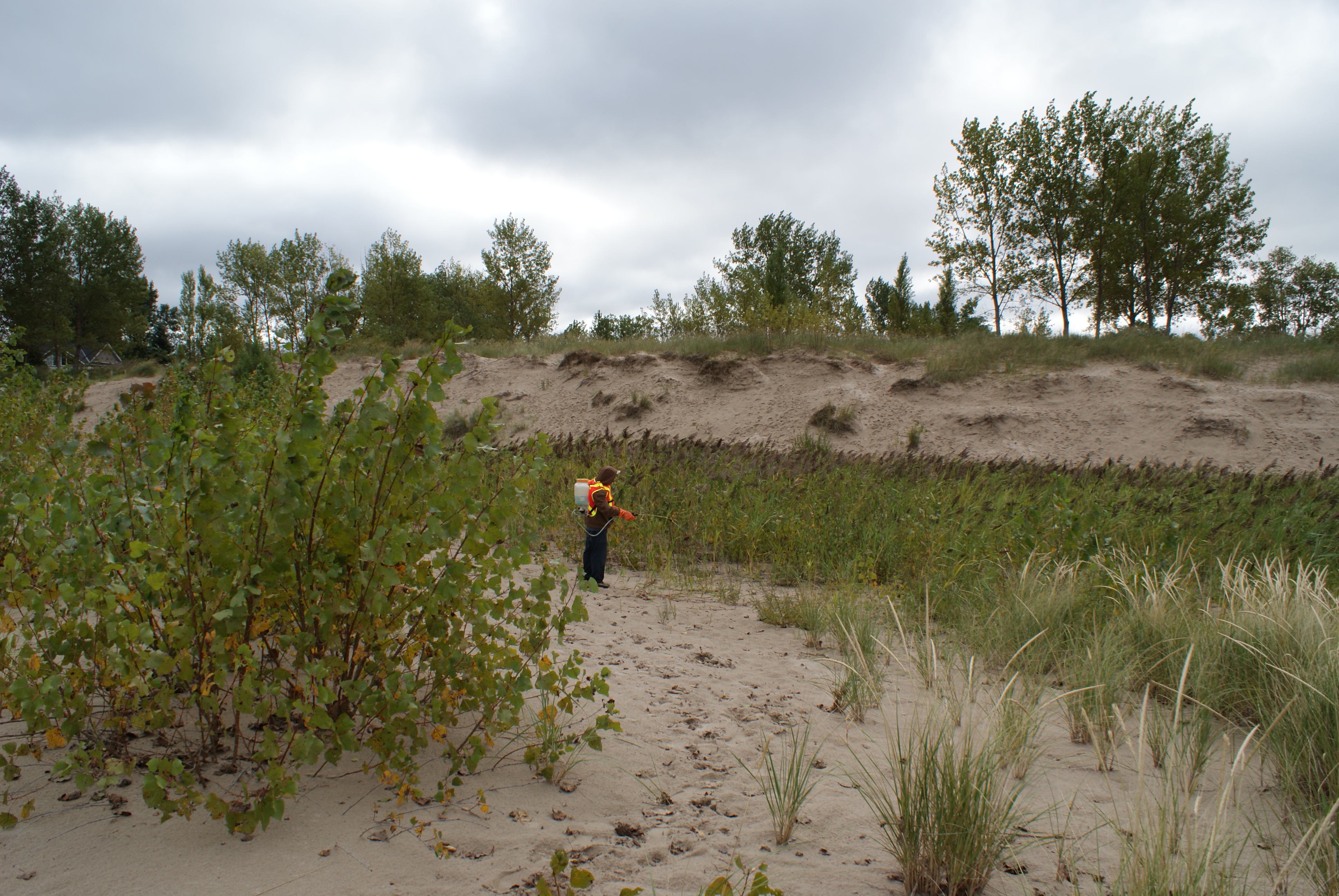
Controlling a patch of non-native Phragmites within a sensitive coastal dune on Port Franks beach using a hand pump backpack sprayer. Photo courtesy of LSPCG
Management Objectives
With a broad partnership base (see Partnerships and Administration), a number of management objectives surfaced. Initially, homeowners focused on reducing the potential impacts of non-native Phragmites on property values. As the partnership expanded, the focus grew to reducing the impacts on sensitive coastal dunes and wetlands, which are environmentally and economically significant to this area.
The LSPCG uses a regional approach with the ultimate goal of a “Phragmites Free” municipality, and partners use direct management and community engagement to work toward this end. The objectives are to: control monoculture stands of non-native Phragmites along the Lake Huron shoreline and in wetlands, control the spread through vectors such as roadside ditches and drains, remove fire and traffic hazards, and eliminate harmful or ineffective management techniques.
Accomplishing these objectives will restore recreational use, aesthetics, valuable ecosystems, and native plant diversity, and will positively impact wetland-dependent species, including a number of Species at Risk. Including a focus on the MLS’s economic bases of tourism, recreation, and agriculture helps engage a broad sector of the community. However, a lack of available management tools (wetland-safe herbicides), the high cost of management, and a limited feeling of shared responsibility create challenges to achieving the ultimate goal.
Prioritization
A Management Plan was prepared by a wetland ecologist and the chair of the LSPCG with significant input from landowners and partners. It was adopted by the MLS council and endorsed by the local Conservation Authority. It identifies separate priorities and suggests a progression for the management of non-native Phragmites within each PMA, so that work within individual PMAs can move forward as funding is available. This plan, adopted in year 5 of the partnership, provided the needed guidance to help move management forward, and continues to serve as a guide for local actions.
Landscape-scale management prioritization principles are central to the plan. They include managing outliers at the same time as treating large infestations, maintaining a follow-up regimen, reducing opportunities for spread, and protecting sensitive habitats. The plan also considers feasibility, such as the potential for partner involvement and coping with the lack of approved herbicide for over-water treatment.
Confusion regarding land ownership as well as large properties owned by developers or farmers who have no immediate interest in restoring the shoreline reduce the ability to follow through with all of the recommended prioritizations.
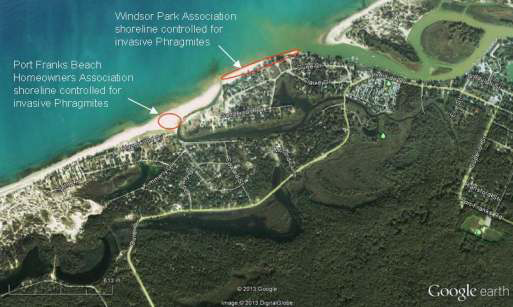
Location of the initial Phragmites control efforts undertaken on the Port Frank’s shoreline. Image courtesy of Janice Gilbert
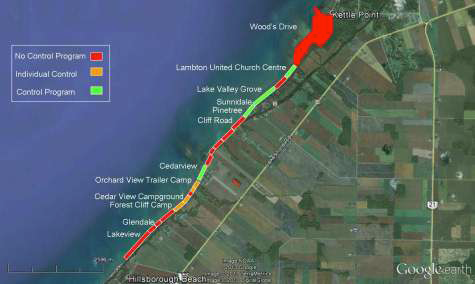
Lake Huron shoreline in West Bosanquet showing areas where Phragmites is being controlled and where it is not controlled. Image courtesy of Janice Gilbert
Policy and Regulations
Different management activities conducted within the MLS have different requirements and permits:
| Activity | Requirement |
| Herbicide Use | Letter of Opinion from the Ministry of Natural Resources and Forestry (possibly waved if the Conservation Authority is involved with the project, exempt on agricultural land) |
| Burning (over 1 square meter) | Open Air Burn Permit from the Municipality of Lambton Shores, valid for one day, must be submitted two days in advance |
| Burning on Crown land (Federally owned) | Low Complexity Prescribed Burn Plan from the Ministry of Natural Resources and Forestry |
| Volunteers become “Certified Technicians” or “Licensed Applicators” to apply herbicide | Certification obtained through online education program and field-work overseen by licensed applicator. Must work under the Conservation Authority or a licensed contractor to have insurance and liability coverage |
| Management conducted on private property | Permission provided by the property owner |
Delays for required letters or permissions have caused delays of a year in initiating some projects, resulting in larger infested areas and higher project costs. Because of unpredictable weather conditions, burn permit requirements are burdensome, often resulting in multiple permit application submissions for a single project.
Non-native Phragmites is not on the MLS’s noxious weed list, so property owners are not legally compelled to remove it.
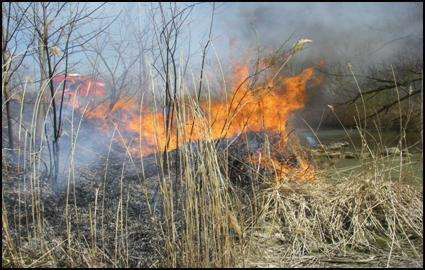
ettle and Stony Point First Nation volunteer fire department burning cut Phragmites along Shawshawanda Creek, April 2013. Photo courtesy of Janice Gilbert
Communication and Outreach
Outreach has been a critical component of the LSPCG’s work because of the project scope, level of infestation, visibility of the work, lack of initial awareness among MLS residents, and because chemicals are used. Providing answers to questions and concerns and serving as a trusted source of accurate information has helped lead to a successful program.
Initially, MLS council members and other members of the government were unaware of the issue of non-native Phragmites, so the LSPCG presented to council on several occasions to educate, update, and request support from members. One council member was enlisted to attend LSPCG meetings, and municipal and council staff were invited to attend site visits. The LSPCG also set up meetings and site visits with members of the Provincial and Federal governments, and representatives from the Ministry of Natural Resources and Forestry, the Ontario Federation of Agriculture, Lambton County Public Works, and local media.
In the first few years of the project, the LSPCG offered four community information sessions. They were advertised with press releases and received media coverage, further spreading their educational reach. LSPCG members also presented at local community group meetings such as Rotary and interest-based clubs, garden and horticultural societies, and beach or cottage associations. The group assisted in the preparation of educational pieces including Smart Practices for Controlling Phragmites along Ontario Roadsides, and prepared the fact sheet Controlling Phragmites australis in Agricultural and Rural Areas.
LSPCG members identified over 125 privately owned parcels along waterways which contained non-native Phragmites. They then visited property owners to provide information about the project and obtain permission for herbicide application and controlled burns. Additionally, an educational piece was mailed to all MLS residents with their tax notices.
To help train field staff, such as those from municipalities, non-profits, and private businesses, the LSPCG partnered with the Lake Huron Centre for Coastal Conservation and the Ontario Phragmites Working Group to develop and deliver training opportunities that focus on identification and appropriate management techniques. Additionally, one partner developed monitoring sheets, which are widely used throughout the MLS.
Finally, a highly visible demonstration project was initiated on Mosquito Island at the mouth of the Ausable River to showcase successful management and increase awareness of the issue.
Strong communication efforts have made a significant contribution to the success of the program. It has ensured area residents have accurate information from the beginning and has allowed them to have their concerns addressed
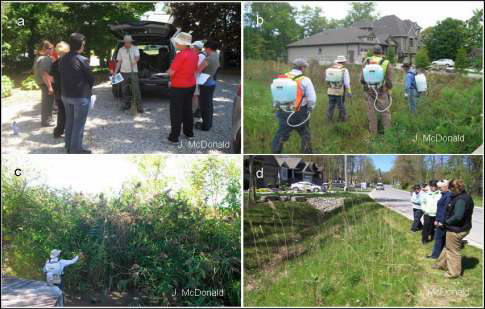
Grand Bend community members participated in a) a Phragmites identification workshop, b) backpack control training for Phragmites in sensitive areas, c) control of dense Phragmites cell, and d) assessing controlled patch for signs of re-growth. Photos courtesy of J. McDonald
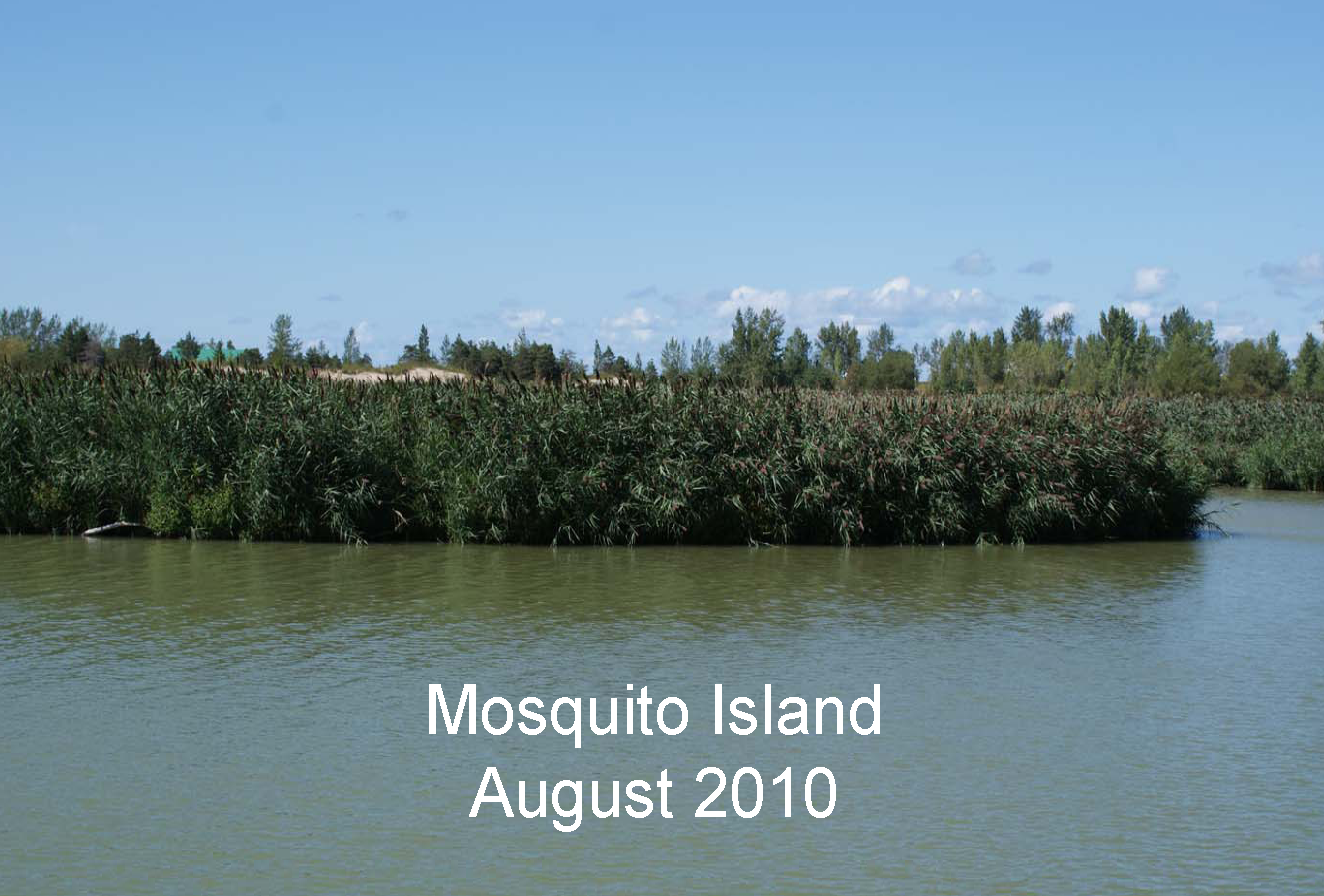
Mosquito Island demonstration site, August 2010
Management
Management techniques used throughout the MLS are site specific and take a landscape scale approach. The Management Plan for the MLS describes recommended methods of control, outlines a management schedule and associated costs, and specifies long-term management strategies for each of seven Phragmites Management Areas. Contingency plans are included in the recommendations, allowing quick adjustments to control activities when site conditions change, without having to go back and seek partner approval. The Management Plan follows the Ontario Ministry of Natural Resources Best Management Practices, which helps build confidence in the approaches. For large sites, a contractor specializing in restoring sensitive habitats, and a burn specialist were hired.
Typically, large, dense monoculture stands are first sprayed with herbicide in August or September, usually from a retrofitted track vehicle, and then are rolled and burned in the next dormant season, from November to March. This timeline reduces negative impacts to native plants, reptiles and amphibians, avoids disturbing birds during critical nesting and fledging seasons (typically April-July), and reduces conflicts with the tourist season. Follow-up treatments are conducted as needed after the initial year of spraying. Lower-density areas are controlled with backpack crews. Volunteers, including some certified technicians, assist with backpack spraying and hand wicking on smaller cells and where follow-up treatments are required. Property owners also help by cutting seed heads or spading (or see Wymbolwood: Management). An airboat is used to control non-native Phragmites along the boat channels and to access islands because this type of boat reduces potential harm to mussels and turtles, which could be hit by prop motors.
Prior to using herbicide for management, manual methods of removal were used and found to be both unsuccessful and labour intensive. After the first year of herbicide treatment, most sites have had 85-95% reductions in non-native Phragmites cover and significant returns of native vegetation.
In Canada, non-native Phragmites in standing water cannot be controlled using herbicide due to the lack of a legally available products, so these areas are cut or rolled to stress the plants and dampen further establishment, spread, and seed head development. However, high lake levels in 2013 and 2014 hampered efforts to restore large sections of Lake Huron meadow marsh, and during the 2014-2015 winter, large iced-over Lake Huron sites were unable to be rolled or burned due to greater than usual snow depths and unsuitable burn conditions. The lack of available herbicides for managing non-native Phragmites in standing water means that some stands that should be high priorities are not managed.
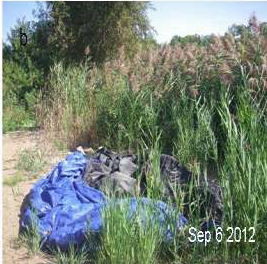
An unsuccessful control effort using tarps. Photo courtesy of Janice Gilbert
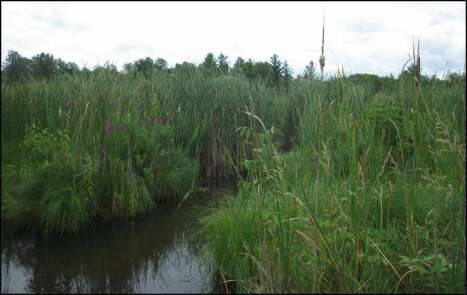
These patches were not controlled due to wet conditions. Image courtesy of Janice Gilbert
Monitoring
Site conditions are measured before and after management activities to ensure outcomes are quantified and the response to restoration efforts can be measured. A wetland ecologist conducts the majority of monitoring activities, sampling several one-square-meter plots at each site for non-native Phragmites density, vegetation richness, plant diversity, wildlife observations, floristic quality index values, water depth, and soil composition. Specific measures of non-native Phragmites are also taken, including number of live and dead stalks, height, and number of seed-heads. Community volunteers assist in monitoring by using standard monitoring sheets to track plant and animal biodiversity, measure the percent change in non-native Phragmites cover, and maintain site photos. Monitoring provides information to support future grant applications and assist in adapting management practices (see Data and Information Integration), and tracking results helps maintain motivation among community members.
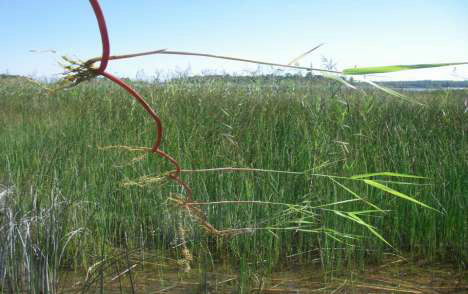
New shoots of invasive Phragmites plants growing out of the rhizome from one parent plant. Photo courtesy of Janice Gilbert
Data and Information Integration
Each year, a wetland ecologist provides a detailed report for each PMA that includes project scope, control actions undertaken (what action, when, by whom), control costs, site conditions before and after management actions (see Monitoring), and recommended program alterations for required future actions based on the ecosystem response to management. These reports are made publicly available and provide an opportunity for LSPCG members to track the progress of the program and plan for the next year of management and monitoring activities. This ensures partners are kept informed of progress, management insights are shared, and resources are used wisely on follow-up treatments. In addition, having this information assists with future grant applications
Outreach Materials
Management Report
Tax Notice Insert
Controlling Phragmites australis in Agricultural and Rural Areas
Smart Practices for Controlling Invasive Phragmites in Ontario’s Roadside Ditches
Community Group Meeting Presentation
Event Press Release
Sample Community Information Session Agenda
Information Session Flyer
Fact Sheet
News Coverage
Volunteers Cut Seed Heads
Phragmites: A Growing Concern
Gaining Provincial Support in Fight Against Phragmites
Lambton Shores Leading the Way in Phragmites Control
Efforts Continue to Make Lambton Shores “Phrag FreeZone”
Ausable Bayfield Conservation Authority Awarded Great Lakes Guardian Community Fund Grant
Controlling Phragmites in Drains and Roadside Ditches
Phragmites Group Asking for Environmental Facilitator
Thank you!
The GLPC would like to thank the following case study authors and contributors for their hard work and commitment to a great product.
Nancy Vidler
Board Chair
Lambton Shores Phragmites Community Group
Bill MacDonald
Board Member
Lambton Shores Phragmites Community Group
Email the LSPCG at lspcg2014@gmail.com or connect on twitter @LSPCG
Janice Gilbert, Ph.D.
Gilbert and Associates Wetland and Aquatic Ecosystem Specialists
janicegilbert@rogers.com

